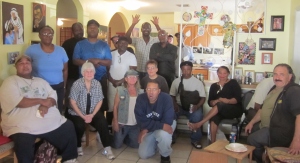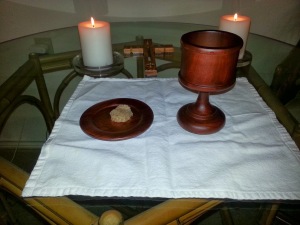 |
| Cliffs of Moher in County Clare, Ireland |
Holy Delighting is at
the heart of the Celtic mystical tradition.
Edward
Farrell, in his spiritual classic, God is Very Fond of You shared a
story about an elderly Irish man who described his relationship with Holy One
as a loving gaze between friends in which no words are necessary. As he sat in
the quiet, the man simply knew that God was very fond of
him.
So, as we begin our
sharing, let us take a few minutes to experience God's love embracing us in Celtic holy delighting. If you have Celtic instrumental music, you may wish to play is softly in the background as you journey to your spiritual center.
I invite you to close our eyes and take a few deep
breaths... Let go of the tensions of the day... Let go of any distractions,
simply let them float away as if they were leaves floating down a river...
drifting away...
Imagine God sitting with you, calling you by name and saying,
“I love you”...."You are the Beloved"...
Be aware that God is very fond of you...
Give thanks for your Belovedness...
Give thanks for the Belovedness of your family, friends, everyone....
Delight in God who
loves you beyond your fears and in your dreams....
Open yourself to the God of Surprises as you embark on this pilgrimage....
A Celtic spirit sees
God's action as
integral to moment-to-moment living. Every aspect of life is enabled by God and
enlivened by God. It is the kind of God-awareness that inspired many Irish
mothers (including my Mother, Bridie) to begin each day with the phrase: "In the name of God." The awareness of
being immersed in the holy in the midst of a circle of love like a cocoon or a
womb which God has woven around you. This
is core to the Celtic understanding of life.
For the Celtic soul,
there are moments and places where the veil between present reality and the
next world are so thin as to be nearly transparent. These
are holy places or holy moments and are often referred to as thin places. Holy wells, cemeteries, high crosses,
ruins of buildings-these
are thin places where one cannot help being drawn to awe-filled prayer in the
presence of the holy. The Celtic soul sees with a vision that can only be
called "faith-eyes."
A loved one is never far
removed, whether merely absent or with
God, since the Celtic life
of faith lives more in God's
ever-present time (kairos) that in our chronological time (chronos).
In 1999, I returned
with my Dad to cottage where Mom and Dad were married and where I lived the
first 8 years of my life, It was the near the first anniversary of my mother's death. Dad and I were still grieving
her loss in our lives. Then, as Dad and I stood outside the cottage, gazing at
the river reflecting on the years that we lived here in the small gray cottage
bordering the river, we saw two beautiful white swans gliding serenely on the
surface of the Erkina River. For Dad and I just standing there was a moment of
contact with family roots, a thin place where
we could feel Mom's presence. It was as if Mom was with
us, assuring us that she was just a breath away.
Celtic
spirituality is imbued with the sense of the family of God, the communion of saints, as a spiritual
bond connecting the living and the dead. The Irish wake,
the tradition of accompanying the dead person on the journey into heaven
reflects this view. When my grandfather Patrick Beale,
died, he was waked in his cottage where family and friends gathered for an
all-night vigil of storytelling, music, song, tears, and food, and laughter.
The next day a large procession of family and neighbors accompanied Pat to the
church for the liturgy and to the cemetery for Christian burial. In the Irish
tradition, there is a Mass celebrated for the deceased one month after death,
and it is common for family and friends to pray for a deceased loved one, for
he or she is, after all, only a prayer away from us.
In
the theology behind Celtic spirituality, and contrary to Augustine's view of sin as an evil disruption of
original innocence, is the gentler insight that saw human
beings as essentially God-centered, since the creating light of God dwells
within all persons. The divine light had been covered over and stifled by the
inroads of sinful choices, but not extinguished.
We are, as John's
gospel says, begotten
by God's light which is
the light of humankind. The Celts are more comfortable with a theology of original blessing than Augustine's concept of original sin.
The
Celtic soul calls us to contemplate earth's
beauty and join in the dance of life in celebrating the magnificence all around
us. The Celtic soul calls us to spend time outdoors
where mountains stretch our minds, and lakes and rivers refresh our spirits. In
fact, the connection between water and spiritual power is a characteristic of
Celtic spirituality. Lakes, rivers, springs, and wells are prominent in Celtic
myth and associated with certain figures. In ancient times, women even went to
holy wells to give birth. In Christian times, the Virgin Mary and several women
saints including Brigit, Ita, Gobnait, Monenna, Dymphna, Non, Tegla, and
Winefride, are associated with springs, and water from these places is used in
rituals and prayers for healing.
Celtic
holy wells continue to be healing sanctuaries and reminders of the influence of
pagan traditions on aspects of Christian faith. In our present-day evangelizing
efforts, a growing awareness exists of the incorporation of indigenous rites,
rituals, and customs into Christian practice where these can be adapted.
We are realizing that those peoples to whom we are reaching out already have
keenly developed spiritual insights regarding the power of the Divine in their
lives, for the same Holy Spirit draws and inspires every human being.
Fortunately, in evangelizing the Celtic people in the early centuries of
Christianity, the missionaries adapted all that was compatible with
Christianity. That is why holy wells and their accompanying rituals are still
common in Celtic spiritual practice.
One of these holy sites, Ladywell, near Ballinkill
in County Leix, is still a popular pilgrimage site. Every year from before
anyone can remember, people from Leix County gather at Ladywell to drink from
and bathe in its waters, making a pilgrimage there especially on August 15 when
a Mass is offered to celebrate the Feast of the Assumption of the Blessed
Virgin Into Heaven. The Ballyroan Brass Band plays, and stories of cures and
answers to prayers are retold.
A
Celtic heart is a pilgrim heart. Celtic saints often
undertook a journey to what they termed their place of resurrection usually a site far away where they were to perform some good
work, and die there, stepping into eternity in exile from their earthly roots
and home. Such a pilgrimage to one's place of resurrection was usually a
long journey. Every pilgrimage, whether short or long, is an enactment of our
life's journey. It
represents the yearning heart, longing for an encounter with God. It is more
than a trip or tour, because the pilgrim is seeking ardently for a meeting with
the Divine without knowing exactly what surprise is in store. The pilgrimage is
actually a response to God's
invitation to relinquish control, to step out and risk all, without knowing the
full consequences.
In
Celtic tradition, the pilgrimage was far more rigorous than anything we might
undertake today. The pilgrim set out, often by sea, to a
totally unknown destination, believing that God was leading.
It was always away from the familiar and the familiar was Ireland, so dear
for its hearth and family ties. Ireland's
landscape with its forty
shades of green, its brilliant rainbows, its starry nights and air-crisp freshness was dear to
every pilgrim-voyager who left with an awareness that there would most likely
be no return. Such were the journeys of Colmcille to Iona and Brendan the
Navigator to Britain, and of the women: Ia to Cornwall, Melangell to Wales,
Cannera, Dymphna and others who traveled to far countries. For that matter, the
same is true of Gobnait, who traveled without settling anywhere until she would see nine white deer grazing
together. That sign would signal the site for the establishment of her monastery, and the
place where she was to await her resurrection. A loose grasp of a faith-journey in which the
Christian allows God to be the captain of the ship and the guide of the
traveler's
steps is a mark central to the inner listening of Celtic spirituality. Such
drastic pilgrimages of those early saints were called a "white martyrdom."
One author of a book
on Celtic pilgrimage sites has observed that for centuries The religious patterns or rounds [used at
the holy wells] usually consisted of recitations of the rosary and repeated
circling of the well with the pilgrims perhaps on their knees performing acts
of penance.. A
longing for healing was a
major motivating factor in such visits to the wells, with the water
being bathed in, drunk, or carried home....Modern scientific analysis has in
many cases shown that the mineral content of certain wells does indeed contain
medicinal qualities and may assist in the healing of certain sicknesses.
Typically the one seeking healing would leave behind at the well, tied to a
tree or a bush, a small rag torn from his or her garment, symbolizing the
leaving behind of the ailment. (Sister Cintra Pemberton, Soulfaring, Harrisburg, Pa: Morehouse Publishing,
1999). At several holy wells in both Ireland and Wales, we
noticed symbols left behind visitors: rags hung on trees at Monenna's well in S. Armagh, coins in Saint
Brigit's well and Saint
Dymphna's well in
Ireland, and flowers at Saint Non's
well in Wales.
My exploration of
Celtic holy women and their healing wells took two years of research and
resulted in a book entitled, Praying with Celtic Holy Women co-authored with a
friend and companion Regina Madonna Oliver. I led a Celtic Sacred Journey to Mystical
Ireland in 2000. Both book and pilgrimage are a
celebration of the feminine spirit, the mystical vision, the creation-inspired
heart, the generous hospitality, the sense of joy, the holistic approach to
life that is found in the richness of Celtic spirituality and culture. So we
welcome everyone, regardless of age, culture, gender, or ethnic origin to join
us in an adventure of the spirit in our
journey to the soul of the Celtic soul. (in both book and pilgrimage to Ireland in 2014)














